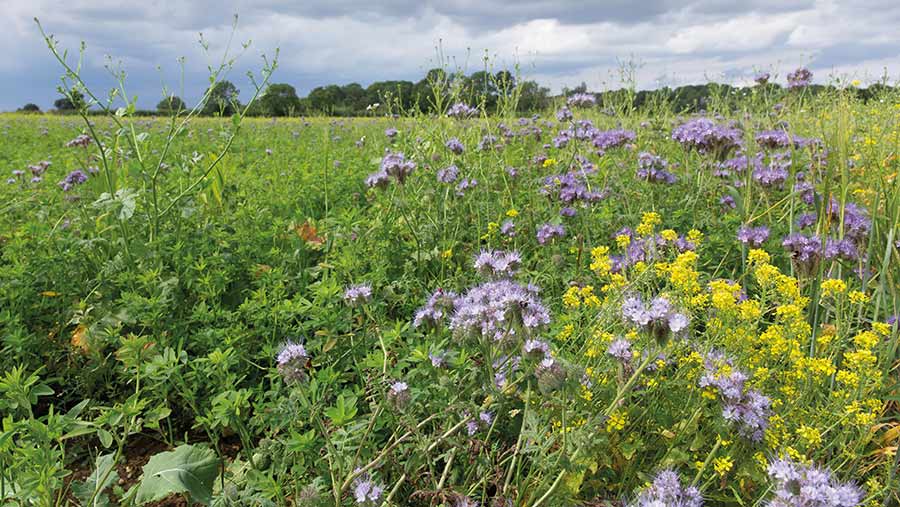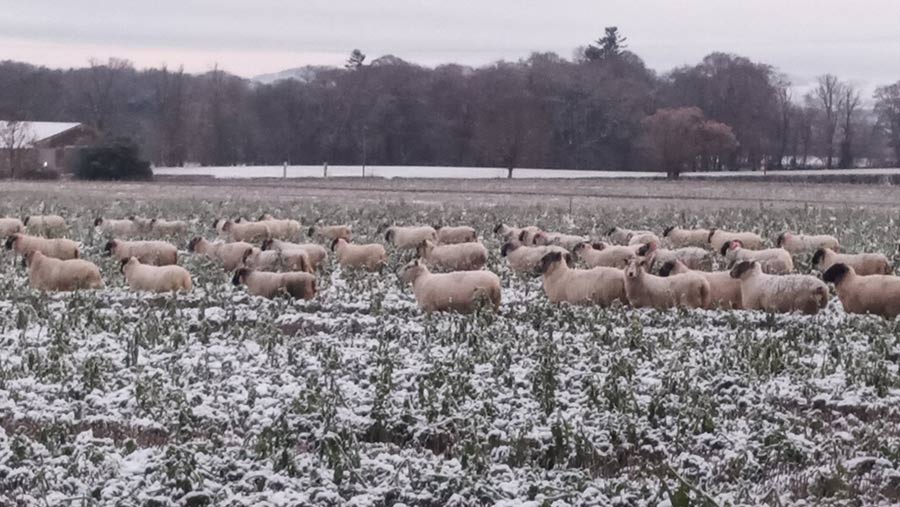Regenerative agriculture: What does the evidence say?
 © Tim Scrivener
© Tim Scrivener Regenerative farming systems go beyond the “feelgood factor” and are helping to reduce emissions, increase biodiversity, enhance public goods and deliver higher farm profits, according to research findings.
At this year’s Base-UK conference, a succession of speakers discussed the results of research examining the outcomes of regenerative agriculture – most of which was done in the UK.
See also: Video: UK’s largest agroforestry system integrates fruit and arable
From the Allerton Project in Leicestershire, Alastair Leake summarised projects stretching over the past 20 years, from soil and water protection (sowap) in 2003 and the on-going Syngenta conservation agriculture work, up to the current AgriCapture carbon dioxide project.
Biodiversity and profit
He revealed that the first of these projects had confirmed soil and water were protected when tillage was reduced, which had positive knock-on effects on biodiversity.
“There was a reduction in soil erosion and run-off, earthworm and bird numbers were higher, soil biology benefited as did aquatic life.”
The work done with Syngenta – on two sites with different soil types – has gone further, he added, and bought in the financial results.
“It’s more profitable,” he said. “On the light land site in Kent, the net profit was up by 36%. On our heavy land at Loddington, it increased by 19%.”
That work also addressed practical issues, such as work rates and operation costs, as well as greenhouse gas emissions and carbon footprints – with the latter two coming down sharply in a no-till regime.
The ups and downs of conservation agriculture |
||||
On the Up |
||||
Bird sightings |
Earthworms |
Net profit |
Work rate |
|
| Light land | 145% | 75% | £36/ha | 56% |
| Heavy land | 1,011% | 8% | £19/ha | 48% |
Going Down |
||||
Soil greenhouse gas emissions |
Carbon footprint |
Fuel use |
Operation cost |
|
| Light land | 13% | 9% | 46% | 50% |
| Heavy land | 20% | 10% | 47% | 10% |
| Source: The Allerton Project/Syngenta | ||||
Reducing greenhouse gas emissions
For Becky Willson of the Farm Carbon Toolkit, providing evidence on how to reduce greenhouse gas emissions is a key part of the organisation’s remit, so that farmers can make the right decisions and improve resilience.
The organisation’s work shows that enhanced soil carbon storage can deliver greenhouse gas of 5m tonnes of carbon dioxide equivalents/year, with farmer management having an effect on the results.
“There is a lot that farmers can measure when it comes to carbon, so they should focus on the things that will help them with management decisions,” she stressed. “Think about what information it is giving you.”
Where building soil carbon is the focus, it can be measured, although there is debate about the best method, she confirmed.
Both the Loss on Ignition (LoI) and Dumas techniques are used – with the Dumas method being more expensive, but likely to be recognised by the forthcoming Soil Carbon Code.
For arable farmers, the biggest impacts on greenhouse gas reductions are seen where ploughing has ceased and cover crops with no-till are being used, she said.
“Cover crops on their own have given mixed results and we are continuing to look at these.”
Results from diversity
Independent soil health consultant Joel Williams provided plenty of proof of the benefits of diversity in cover crops and rotations, from a wealth of studies.
As well as having soil, water and biodiversity advantages, plant diversity also helps with agronomic challenges, he revealed, by improving soil fertility and nitrogen use efficiency, managing weeds and pests and producing forage.
In terms of soil biology, there was a 27% improvement in soil microbial abundance, with a similar improvement in microbial activity. “Certain species in your cover crops help with this more than others.”
Where pest and disease levels are concerned, there’s a suppressant effect seen from having an extra species, such as with intercropping or companion planting, in 79% of occasions. Similarly with pests, pressure was down by 68%.
With weeds, the design of a system that has more diversity in it makes it harder for weed populations, as confirmed by a reduction in 86% of situations, added Mr Williams.
A large study on nitrate leaching showed a fall of 56% where cover crops were employed, with those being drilled earlier capturing more nitrate, as well as those on lighter soils.
Interestingly, legumes on their own did not capture as much nitrate as a mix.
“Another finding is that the carbon dioxide uptake is twice as high in a four species cover crop mix and three times higher in a mix of 12 species.
That results in higher transport rates in the plants towards the roots and a better effect on the soil.”
While there’s no right answer to how many species you should aim to have, including more species will bring more functionality, he added.
“There is a legacy effect seen from a very diverse mix, but it fades over time.”
How to increase plant diversity
- Novel cash crops
- Wider rotations
- Annuals/perennials
- Summer/winter
- Cover crops
- Companion crops
- Intercropping
- Biodiversity strips
- Field margins
- Agroforestry
- Silvopasture
Farm experience: Progress to date

© Duncan Wilson
Duncan Wilson, Strathmore Farming Company, Angus
For Scottish farm manager Duncan Wilson, the focus is on trying to be less degenerative as he combines making a financial return with testing out different ways of doing things.
While carrots have been dropped from the rotation for soil health reasons, the business still grows potatoes and a considerable amount of the land is ploughed.
However, other crop establishment methods are being investigated, cover crops have been integrated into the rotation, bi-cropping is being tested, mob grazing is under way and input use has reduced.
Plenty of hedges, trees and margins, along with rough grazing and wild areas, means that the farm landscape is very diverse, with plenty of space for wildlife.
“We are trying alternatives but we need to be careful about the speed of change,” says Mr Wilson. “No two years are the same and it takes time to get results.”
As well as 1,215ha of arable crops, some 220 spring calving cows are kept on permanent pasture and different grazing systems have been tested, to find the best way of using 810ha of rough grazing.
There are also 640 outdoor sows and sheep are bought in to graze cover and arable crops.
“There is a slight reduction in yield in the arable crops where this is done – it has to be balanced with savings on fungicides.”
Lance Charity, Flood Farm, Cambridgeshire
Producing healthy food is the aim of Lance Charity, a Peterborough Council tenant farmer and relative newcomer, who produces lamb, cereals, eggs, honey and pumpkins.
As well as trying to improve the soils, he is stacking enterprises while reducing inputs and introducing novel techniques such as bi-cropping, so that he makes full use of plant diversity.
A flock of hardy Poll Dorset sheep, which lamb in September, are used to graze multi-species cover crops, with the lambs either being sold to Waitrose or used in the farm’s direct box scheme.
Sheep are also used to graze the arable crops and replace the need for inputs. Where they go onto wheat in the autumn, they are moved daily, to prevent any crop and soil damage and reduce the risk of harm.
Some 300 chickens are also part of the farm, with purpose-built trailers being moved weekly around the farm and the eggs sold direct to the public.
In addition, bee hives are allowing the production of honey and a pumpkin-growing trial in 2022 was successful and will be repeated.
“Getting people onto the farm in September is good as we are lambing then,” he says.
“We are keen to add an educational aspect to our efforts so that people understand more about healthy food.”

